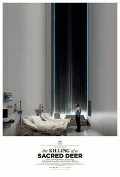
Directed by
Yorgos Lanthimos
121 minutes
Rated M
Reviewed by
Bernard Hemingway

The Killing Of A Sacred Deer
Synopsis: Dr. Steven Murphy (Colin Farrell), a cardiologist married to Anna (Nicole Kidman) an opthalmologist, secretly befriends Martin (Barry Keoghan), a fatherless teen whose increasingly obsessive behaviour will disrupt Steven’s comfortable middle-class life.
Artists, whether painters, musicians or film-makers tend to have one over-riding fixation which they return to time and time again. Going on the three films of co-writer and director Yorgos Lanthimos released here so far, his core preoccupation is a Freudian conception of middle-class society as the repressive imprisoning of the libido. As Dogtooth (2009) was about an industrialist who for personal reasons confines his children to his home even though they were adults and The Lobster (2015) is about singles who opt into a program to find a life partner or be turned into animals so The Killing of a Sacred Deer is about a carefully-ordered bourgeois existence under threat of disintegration.
Despite the surface weirdness, at the film’s heart is the “home invasion” sub-genre of thriller so popular with Hollywood in which a comfortable middle class family is threatened by some vengeful malefactor thus requiring the paterfamilias to save the day (take, for example, Scorsese's 1991 version of Cape Fear- which is more or less the plot of The Killing of a Sacred Deer (that Lanthimos's film is touted as being based on the ancient Greek play 'Iphigenia at Aulis' by Euripides in which King Agamemnon accidentally kills a deer in a sacred grove of Artemis and is as a result ordered by the goddess to sacrifice his daughter, Iphigenia, doesn’t contradict this claim as it's rather like saying that the Coen’s O Brother, Where Art Thou? (2000) was based on ‘The Odyssey’)
Lanthimos uses his now-familiar carefully-honed aesthetic strategies - an oblique and at times opaque narrative, clinically detached visuals, a discordant sound design and dialogue whose rhythms recall David Mamet - Io produce an eerie, estranging (in the Brechtian sense) distance from the Hollywood template. Nevertheless in many ways it is the most accessible of this group of three films. Whilst this certainly doesn’t mean that it will speak to a mainstream audience it actually offers some relatively conventional satisfactions. Farrell, who had starred in The Lobster gives a winning performance as the quietly repressed husband with a taste for submissive sex, something which the seemingly ubiquitous Kidman (they also co-starred in this year’s The Beguiled) provides with grace. Barry Keoghan is also rather good as the strange teen, holding his weight well with his much more experienced co-stars whilst once-teen star Alicia Silverstone appears in a small role as Martin’s mother.
Unlike The Lobster, The Killing of a Sacred Deer, which is arguably the most polished of the director's trilogy-of-sorts sustains its two-hour running time. Having said that, Lanthimos now needs to move on or run the risk of reducing his challenging filmic style to mannerism.

Want more about this film?


Want something different?




